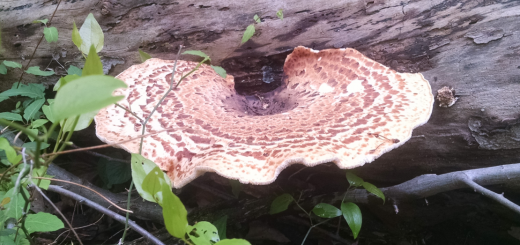#145: Byssomerulius incarnatus, the Coral-Pink Merulius
This bright, attractive fungus is a great example of how confusing mushrooms can be. Byssomerulius incarnatus is distinguished by its bright pink cap and rough undersurface. Although its spore-producing surface is not smooth, it is still considered a crust fungus. To add to the confusion, it is still being shuffled around through a few different genera and it has some kind of relationship with Stereum ostrea (FFF#144) that has yet to be researched.
B. incarnatus is easily recognizable by its bright pink cap. From above, the mushroom looks like a brightly-colored bracket polypore. It is roughly fan-shaped but is irregularly lobed and has a wavy margin. The mushrooms are small, growing 1.5-7cm (about 0.5 to 3in) in diameter. Often, multiple fruiting bodies fuse together to form larger clusters. True to its common name, the mushroom’s cap is coral-pink when fresh. This color fades to become light pink to whitish pink as the mushroom ages. The cap’s texture is usually smooth but may be slightly hairy. Its flesh is white and leathery.
Underneath, the spore-producing surface is whitish and wrinkled. B. incarnatus is considered a crust fungus even though its fertile layer is not entirely smooth. The roughened spore surface often appears veined or nearly poroid or toothed (called “merulioid”). One feature that sets this mushroom apart from the polypores is that it produces spores on the edges of the ridges as well as between them. Polypores, on the other hand, produce spores only in the center of the pores. In the Coral-Pink Merulius, the undersurface is white to pinkish and becomes somewhat tan with age. This surface may bruise yellowish in older specimens.
One of the most intriguing aspects of this fungus is that it is nearly always found growing alongside the False Turkey Tail (Stereum ostrea). The two species are often growing so close together that B. incarnatus partially engulfs an S. ostrea mushroom. There has not been any research into the relationship between the two species. However, everyone familiar with the Coral-Pink Merulius knows that it is hardly ever found without S. ostrea nearby.
Field guides list the B. incarnatus as a decomposer of hardwoods that causes a white rot. This means that the fungus primarily breaks down the lignin in the wood, leaving behind the white, fibrous cellulose. However, its close relationship with S. ostrea suggests that its ecological role is probably more complicated than that.
B. incarnatus can be found in Eastern North America, mostly east of the Great Plains and south of Canada. There is at least one record of B. incarnatus from South America, so the range of the Coral-Pink Merulius likely extends all the way down to at least southern Brazil.
Although I am using the name Byssomerulius incarnatus in this post, most field guides will list this mushroom as Phlebia incarnata. The mushroom has been shuffled around a few different genera, including Byssomerulius, Phlebia, and Merulius. Even though it has not been in the genus Merulius for a long time, it and a few other mushrooms in the genus Phlebia still retain “Merulius” in their common names (at one point, mycologists decided that Merulius was a synonym of Phlebia). To make things more complicated for amateur mycologists, the fungus was once transferred out of the genus Byssomerulius. Its most recent move (from Phlebia back to Byssomerulius) was made in 2014. This decision was not based on DNA evidence, so the fungus is likely to move again. In this case, it may be easier to refer to the mushroom by its common name, the “Coral-Pink Merulius.”
See Further:
http://www.mycoguide.com/guide/fungi/basi/agar/poly/phle/byss/incarnatus
http://www.mushroomexpert.com/phlebia_incarnata.html
http://www.mushroomfarm.com/mushroom-species/crust-fungi/phlebia-incarnata.html
http://www.speciesfungorum.org/Names/SynSpecies.asp?RecordID=310027








![#011: Characteristics of Kingdom Fungi [Archived]](https://www.fungusfactfriday.com/wp-content/themes/hueman/assets/front/img/thumb-small-empty.png)

1 Response
[…] which has pores. Another fungus that does not look like a crust fungus upon first glance is Phlebia incarnata. This fungus produces medium-sized, pinkish brackets that are fleshier than most crust fungi. […]